engine coolant SSANGYONG KORANDO 2013 Owner's Manual
[x] Cancel search | Manufacturer: SSANGYONG, Model Year: 2013, Model line: KORANDO, Model: SSANGYONG KORANDO 2013Pages: 1336, PDF Size: 92.18 MB
Page 390 of 1336
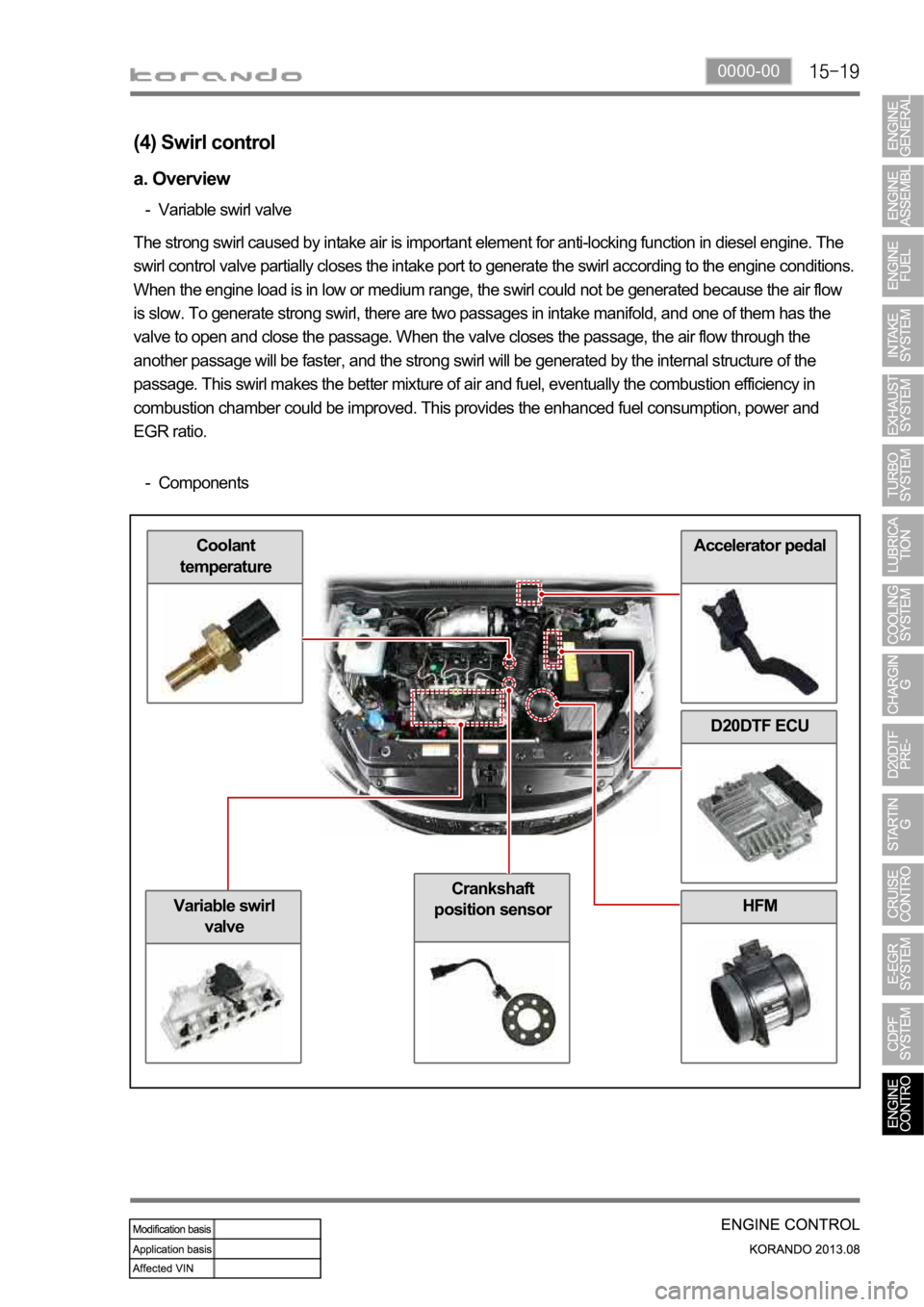
0000-00
HFM
Accelerator pedalCoolant
temperature
(4) Swirl control
a. Overview
Variable swirl valve -
The strong swirl caused by intake air is important element for anti-locking function in diesel engine. The
swirl control valve partially closes the intake port to generate the swirl according to the engine conditions.
When the engine load is in low or medium range, the swirl could not be generated because the air flow
is slow. To generate strong swirl, there are two passages in intake manifold, and one of them has the
valve to open and close the passage. When the valve closes the passage, the air flow through the
another passage will be faster, and the strong swirl will be generated by the internal structure of the
passage. This swirl makes the better mixture of air and fuel, eventually the combustion efficiency in
combustion chamber could be improved. This provides the enhanced fuel consumption, power and
EGR ratio.
Components -
D20DTF ECU
Crankshaft
position sensor
Variable swirl
valve
Page 395 of 1336
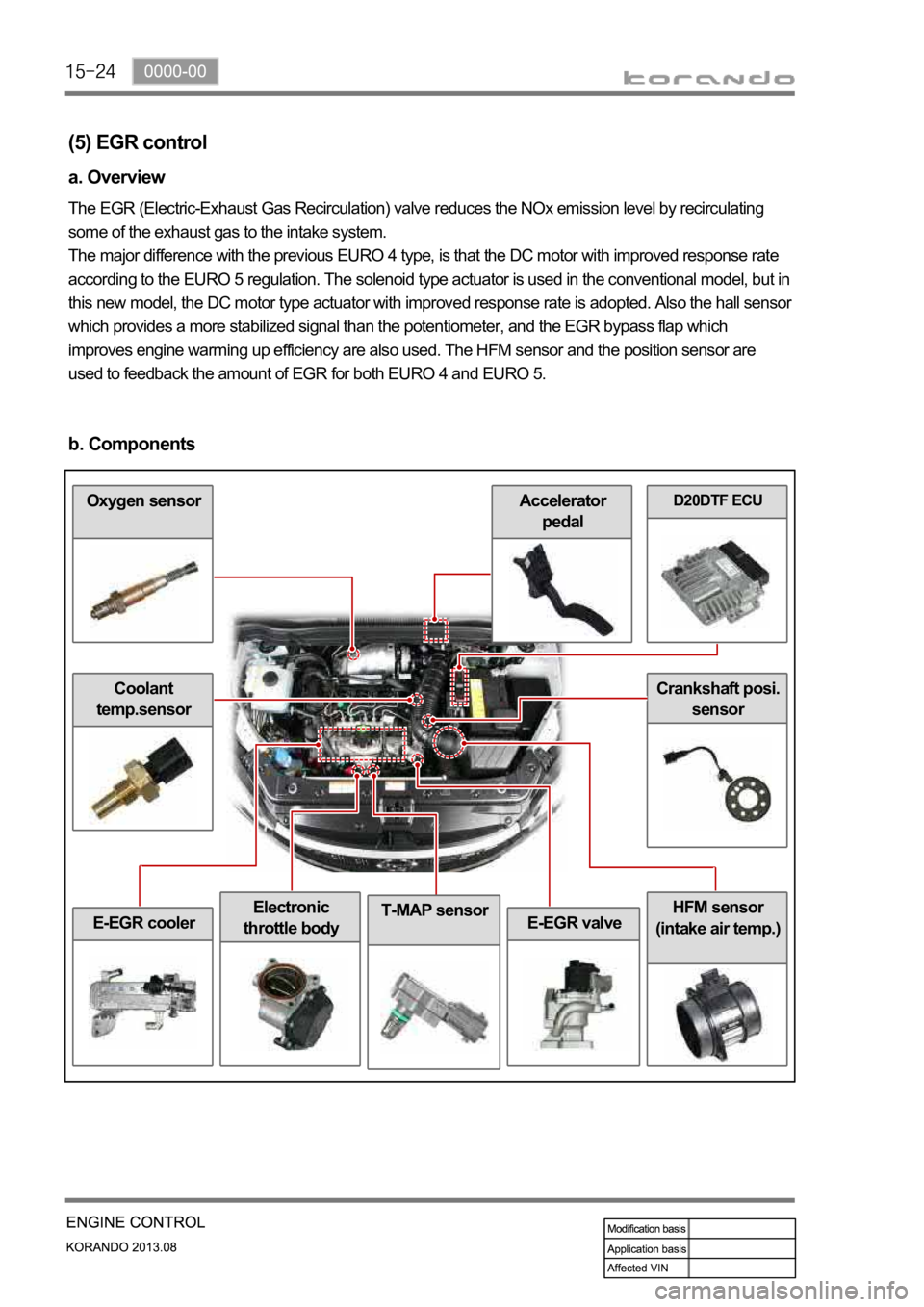
T-MAP sensor
D20DTF ECUOxygen sensor
Electronic
throttle bodyHFM sensor
(intake air temp.)
Coolant
temp.sensor
E-EGR valve
Crankshaft posi.
sensor
Accelerator
pedal
E-EGR cooler
(5) EGR control
a. Overview
The EGR (Electric-Exhaust Gas Recirculation) valve reduces the NOx emission level by recirculating
some of the exhaust gas to the intake system.
The major difference with the previous EURO 4 type, is that the DC motor with improved response rate
according to the EURO 5 regulation. The solenoid type actuator is used in the conventional model, but in
this new model, the DC motor type actuator with improved response rate is adopted. Also the hall senso
r
which provides a more stabilized signal than the potentiometer, and the EGR bypass flap which
improves engine warming up efficiency are also used. The HFM sensor and the position sensor are
used to feedback the amount of EGR for both EURO 4 and EURO 5.
b. Components
Page 397 of 1336
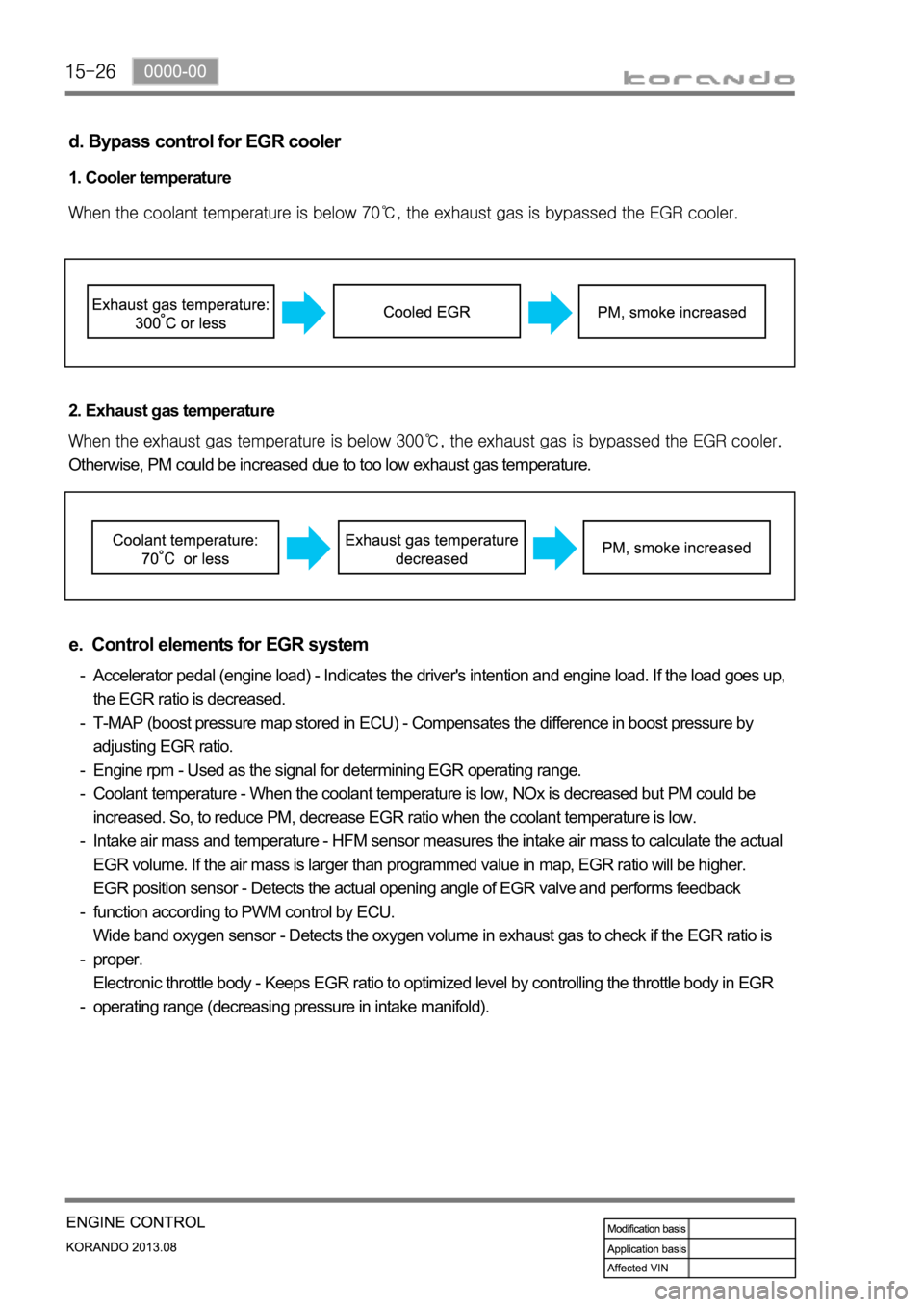
d. Bypass control for EGR cooler
1. Cooler temperature
2. Exhaust gas temperature
Otherwise, PM could be increased due to too low exhaust gas temperature.
e. Control elements for EGR system
Accelerator pedal (engine load) - Indicates the driver's intention and engine load. If the load goes up,
the EGR ratio is decreased.
T-MAP (boost pressure map stored in ECU) - Compensates the difference in boost pressure by
adjusting EGR ratio.
Engine rpm - Used as the signal for determining EGR operating range.
Coolant temperature - When the coolant temperature is low, NOx is decreased but PM could be
increased. So, to reduce PM, decrease EGR ratio when the coolant temperature is low.
Intake air mass and temperature - HFM sensor measures the intake air mass to calculate the actual
EGR volume. If the air mass is larger than programmed value in map, EGR ratio will be higher.
EGR position sensor - Detects the actual opening angle of EGR valve and performs feedback
function according to PWM control by ECU.
Wide band oxygen sensor - Detects the oxygen volume in exhaust gas to check if the EGR ratio is
proper.
Electronic throttle body - Keeps EGR ratio to optimized level by controlling the throttle body in EGR
operating range (decreasing pressure in intake manifold). -
-
-
-
-
-
-
-
Page 399 of 1336
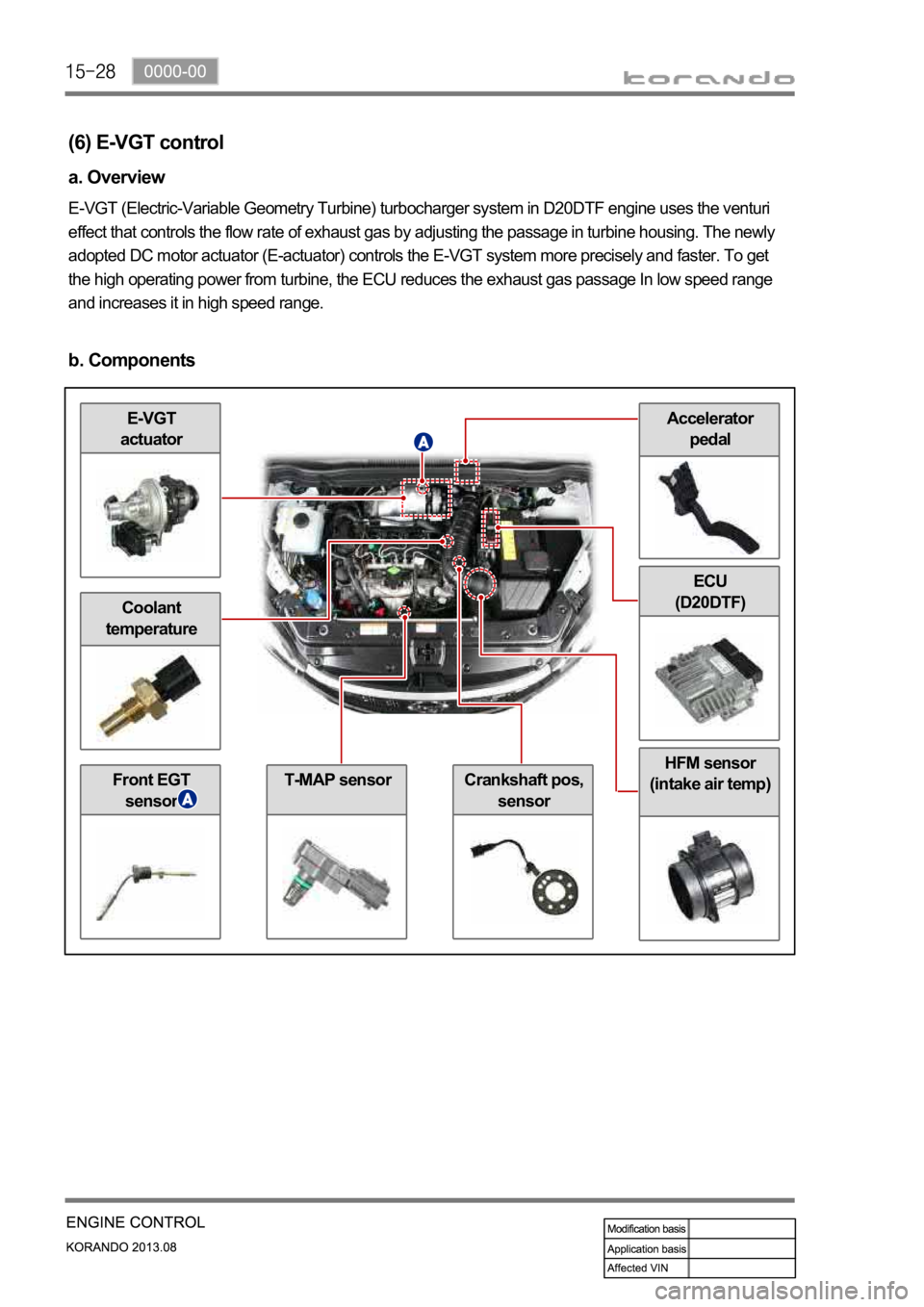
Accelerator
pedalE-VGT
actuator
Coolant
temperature
Front EGT
sensorT-MAP sensorCrankshaft pos,
sensor
HFM sensor
(intake air temp)
ECU
(D20DTF)
(6) E-VGT control
a. Overview
E-VGT (Electric-Variable Geometry Turbine) turbocharger system in D20DTF engine uses the venturi
effect that controls the flow rate of exhaust gas by adjusting the passage in turbine housing. The newly
adopted DC motor actuator (E-actuator) controls the E-VGT system more precisely and faster. To get
the high operating power from turbine, the ECU reduces the exhaust gas passage In low speed range
and increases it in high speed range.
b. Components
Page 401 of 1336
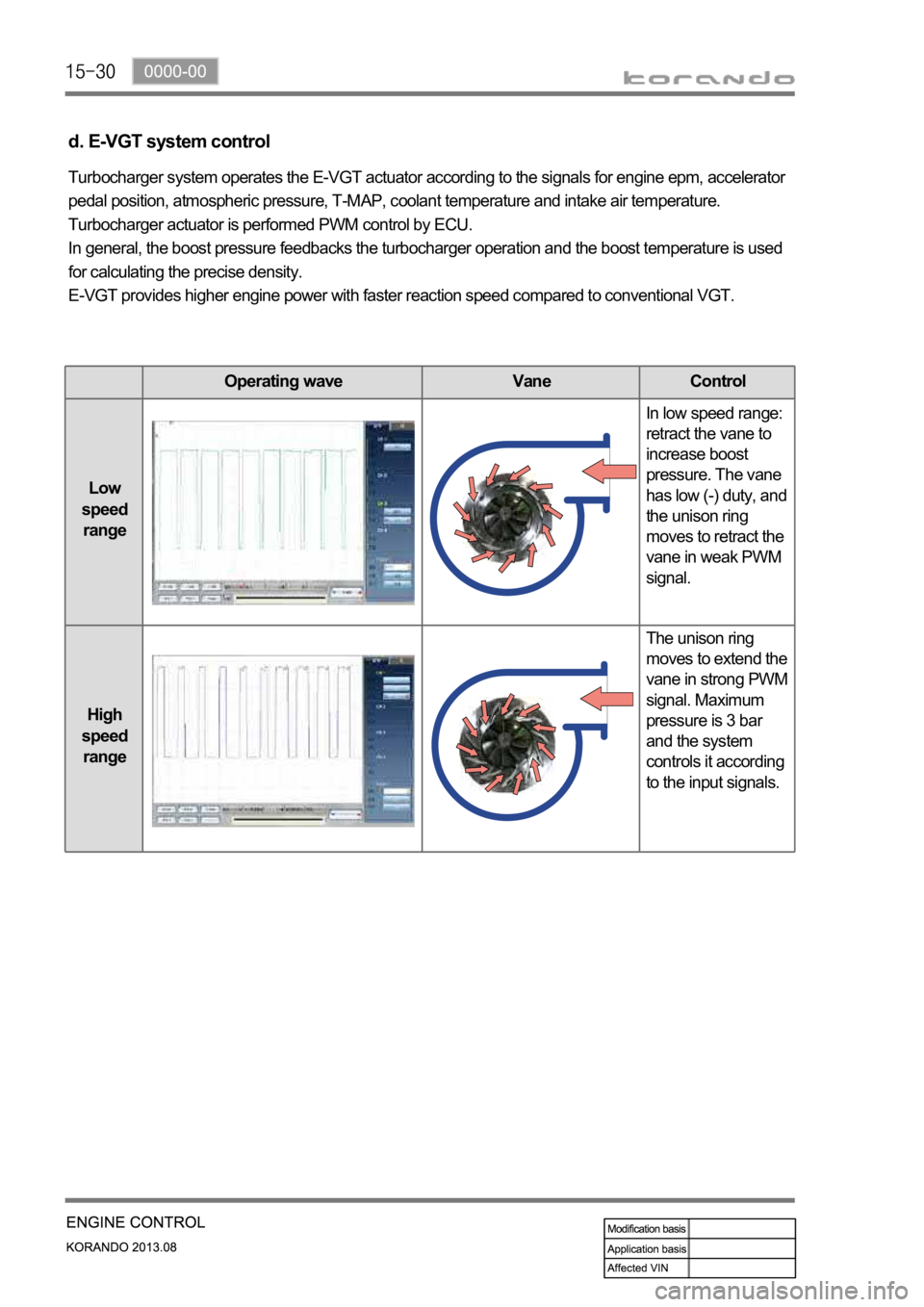
d. E-VGT system control
Turbocharger system operates the E-VGT actuator according to the signals for engine epm, accelerator
pedal position, atmospheric pressure, T-MAP, coolant temperature and intake air temperature.
Turbocharger actuator is performed PWM control by ECU.
In general, the boost pressure feedbacks the turbocharger operation and the boost temperature is used
for calculating the precise density.
E-VGT provides higher engine power with faster reaction speed compared to conventional VGT.
Operating wave Vane Control
Low
speed
rangeIn low speed range:
retract the vane to
increase boost
pressure. The vane
has low (-) duty, and
the unison ring
moves to retract the
vane in weak PWM
signal.
High
speed
rangeThe unison ring
moves to extend the
vane in strong PWM
signal. Maximum
pressure is 3 bar
and the system
controls it according
to the input signals.
Page 402 of 1336

0000-00
HFM sensor
(air mass)
CDPF
(7) Wide band oxygen sensor
a. Overview
For diesel engine, combustion is not performed at the optimum (theoretically correct) air-fuel ratio and
the oxygen concentration is thin in most cases. So the wide-band oxygen sensor is used for this kind of
engine, and this sensor is a little different from the one that used for gasoline engine. The combustion in
diesel engine is controlled by fuel injection volume. Therefore, the wide band oxygen sensor should be
used in diesel engine. This sensor measures the air-fuel ratio in very wide range, and is also called full
range oxygen sensor.
The wide band oxygen sensor measures the oxygen density in exhaust gas and sends it to ECU to
control the EGR more precisely. -
b. Components
D20DTF
ECU
EGR valveElectronic
throttle bodyCoolant temp.
sensor
Oxygen
sensorInjector (C3I)
Page 405 of 1336
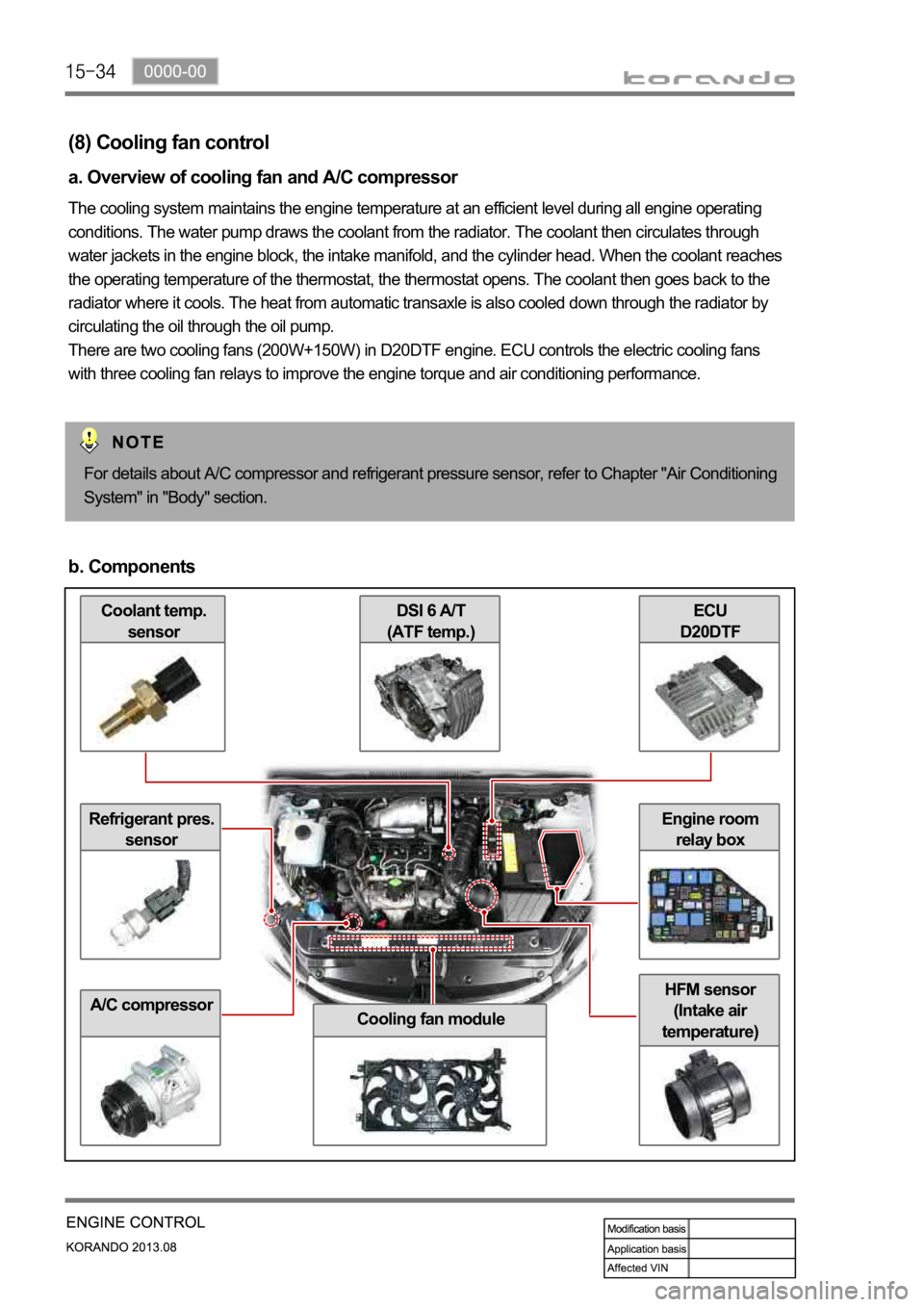
Coolant temp.
sensor
Refrigerant pres.
sensor
A/C compressor
ECU
D20DTFDSI 6 A/T
(ATF temp.)
Cooling fan module
HFM sensor
(Intake air
temperature)
Engine room
relay box
(8) Cooling fan control
a. Overview of cooling fan and A/C compressor
The cooling system maintains the engine temperature at an efficient level during all engine operating
conditions. The water pump draws the coolant from the radiator. The coolant then circulates through
water jackets in the engine block, the intake manifold, and the cylinder head. When the coolant reaches
the operating temperature of the thermostat, the thermostat opens. The coolant then goes back to the
radiator where it cools. The heat from automatic transaxle is also cooled down through the radiator by
circulating the oil through the oil pump.
There are two cooling fans (200W+150W) in D20DTF engine. ECU controls the electric cooling fans
with three cooling fan relays to improve the engine torque and air conditioning performance.
For details about A/C compressor and refrigerant pressure sensor, refer to Chapter "Air Conditioning
System" in "Body" section.
b. Components
Page 407 of 1336
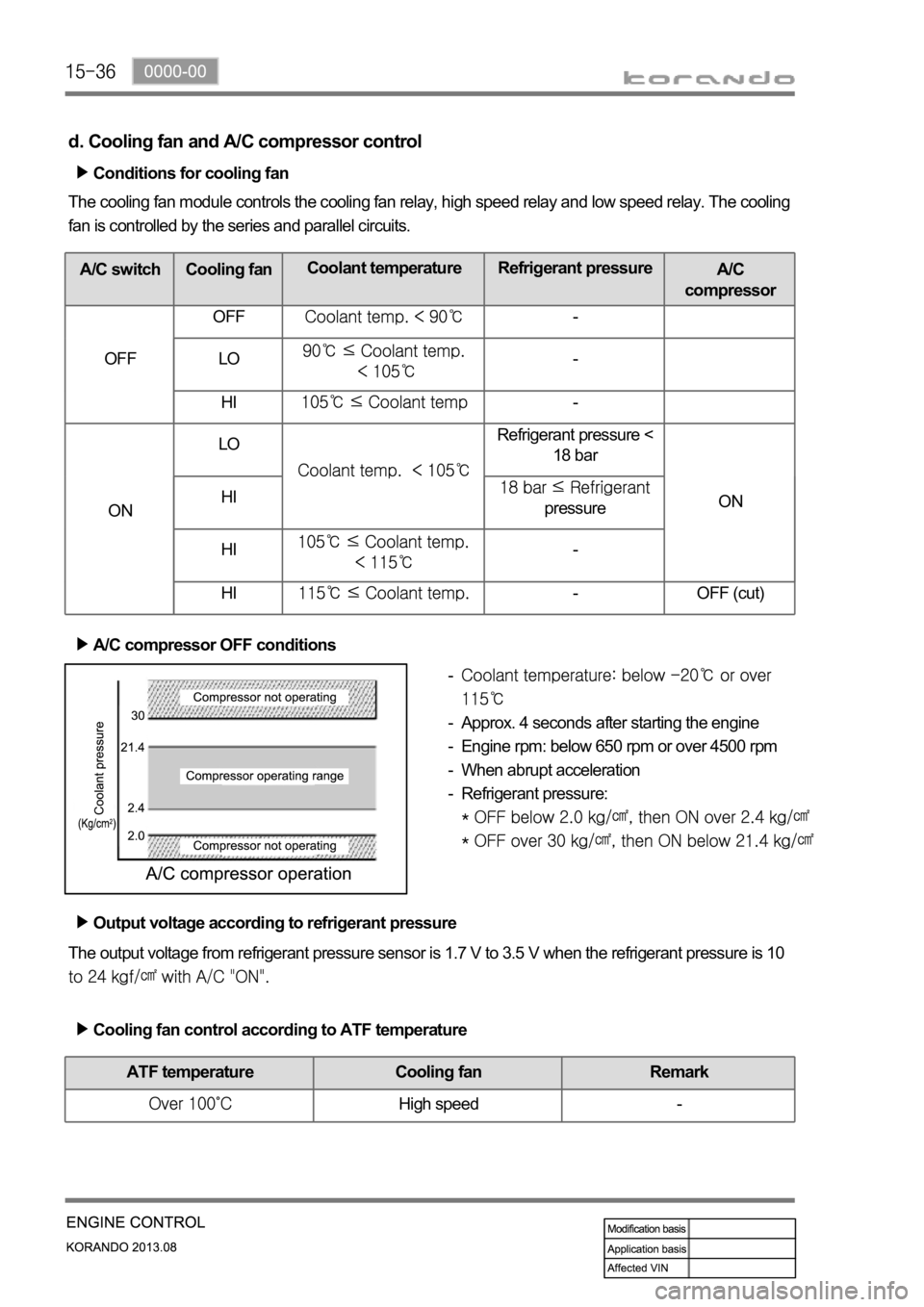
d. Cooling fan and A/C compressor control
Conditions for cooling fan
The cooling fan module controls the cooling fan relay, high speed relay and low speed relay. The cooling
fan is controlled by the series and parallel circuits.
A/C switch Cooling fanCoolant temperature Refrigerant pressure
A/C
compressor
OFF OFF
-
LO
-
HI
-
ONLO
Refrigerant pressure <
18 bar
ON HI
pressure
HI
-
HI
- OFF (cut)
A/C compressor OFF conditions
Approx. 4 seconds after starting the engine
Engine rpm: below 650 rpm or over 4500 rpm
When abrupt acceleration
Refrigerant pressure:
-
-
-
-
-
The output voltage from refrigerant pressure sensor is 1.7 V to 3.5 V when the refrigerant pressure is 10
Output voltage according to refrigerant pressure
Cooling fan control according to ATF temperature
ATF temperature Cooling fan Remark
High speed -
Page 408 of 1336
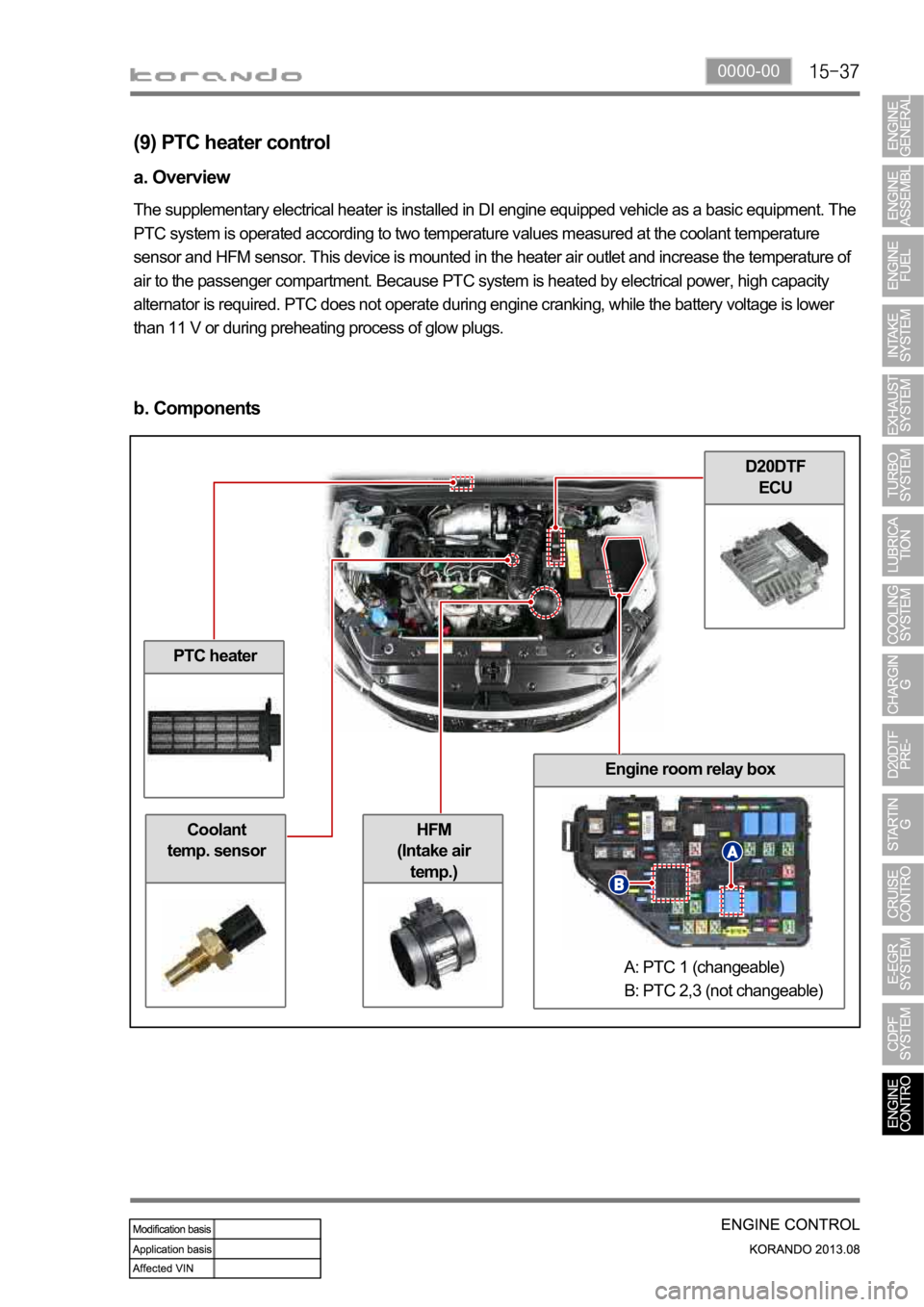
0000-00
PTC heater
Coolant
temp. sensor
D20DTF
ECU
Engine room relay box
HFM
(Intake air
temp.)
(9) PTC heater control
a. Overview
The supplementary electrical heater is installed in DI engine equipped vehicle as a basic equipment. The
PTC system is operated according to two temperature values measured at the coolant temperature
sensor and HFM sensor. This device is mounted in the heater air outlet and increase the temperature of
air to the passenger compartment. Because PTC system is heated by electrical power, high capacity
alternator is required. PTC does not operate during engine cranking, while the battery voltage is lower
than 11 V or during preheating process of glow plugs.
b. Components
A: PTC 1 (changeable)
B: PTC 2,3 (not changeable)
Page 423 of 1336
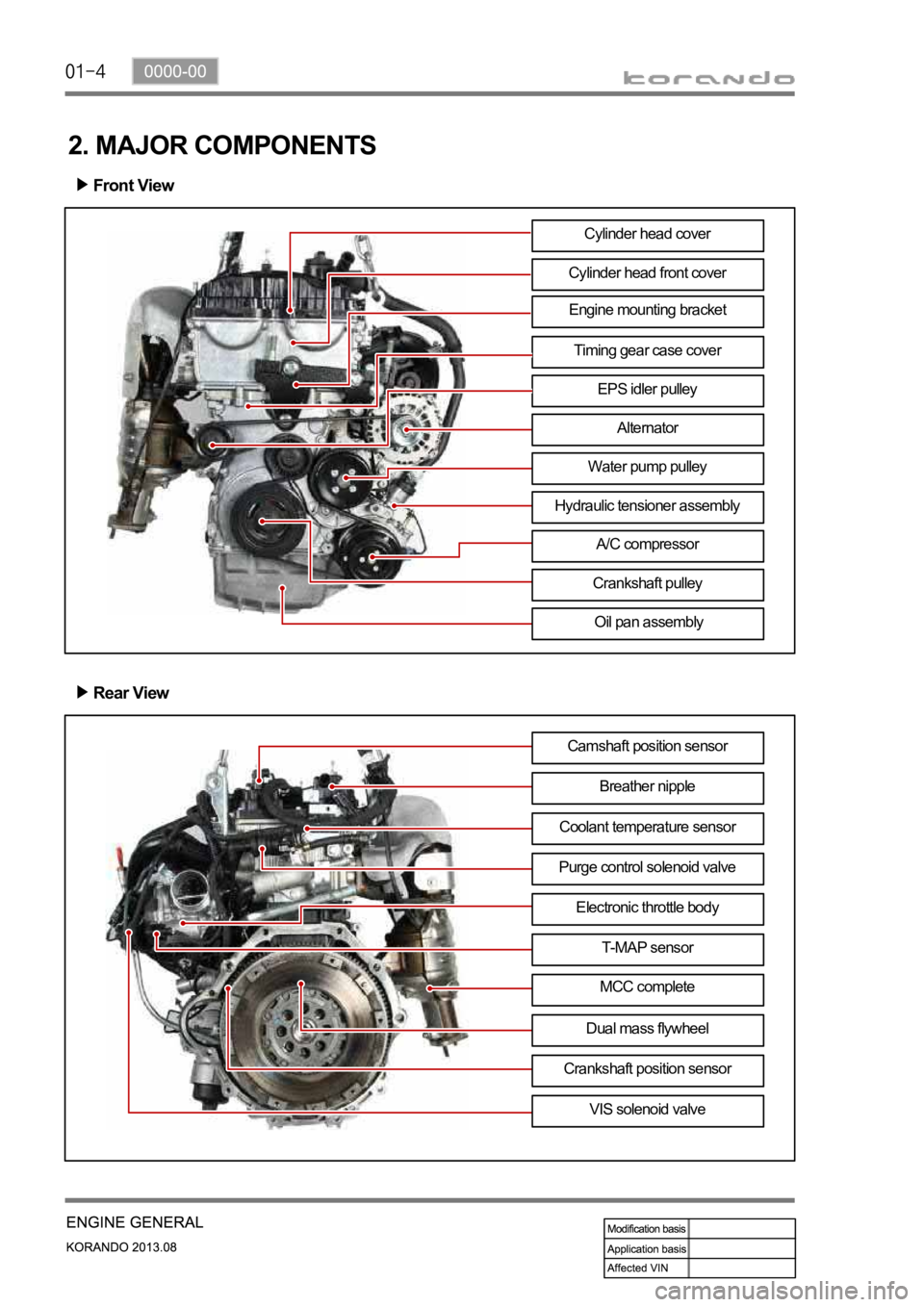
Engine mounting bracket
2. MAJOR COMPONENTS
Front View
Cylinder head front cover
Timing gear case cover
EPS idler pulley
Alternator
Water pump pulley
A/C compressor
Crankshaft pulley
Oil pan assembly
Rear View
Camshaft position sensor
Breather nipple
Purge control solenoid valveCoolant temperature sensor
Electronic throttle body
T-MAP sensor
MCC complete
VIS solenoid valve Cylinder head cover
Dual mass flywheel
Crankshaft position sensor
Hydraulic tensioner assembly